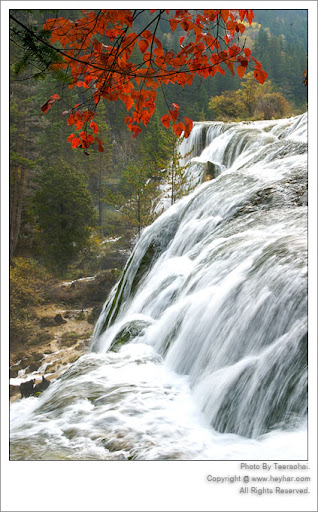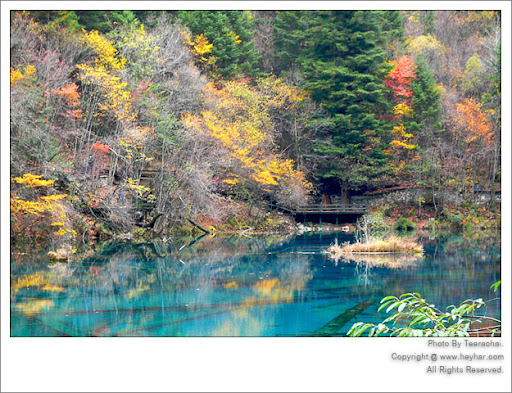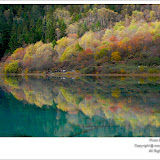 Jiuzhaigou literally means nine-village valley - Jiu is for nine, Zhai for village and Gou for valley.
Jiuzhaigou literally means nine-village valley - Jiu is for nine, Zhai for village and Gou for valley.Jiuzhaigou. It’s 450 kilometer north of Chengdu, capital of Sichuan Province, and is famous for its lakes, rivers, waterfalls, mountains and forests.
In this scenic spot, which stretches for 50 kilometers, two valleys join each other to form a Y-shape from west to east. There are nine villages scattered around the valleys, inhabited mainly by the Tibetan nationality.
In ancient times, Jiuzhaigou was called the Green Sea, because of its dense forests. Its relatively low altitude gives it a warm and wet climate for most of the year. This, added to the thawing snow on the mountains, gives it its rich water resources. Mountain springs, ponds and rivers can be seen everywhere in Jiuzhaigou, with the water so clean it’s almost transparent. In fact, visibility through the water can be 20 meters in some places.
Water is part and parcel of Jiuzhaigou’s beauty. As one saying goes: “When you return from Jiuzhaigou, you do not feel the need to go any other place where water is the major attraction.” There’s a certain truth in this.
In Jiuzhaigou, you can see still water in lakes as green as jade; slowly flowing water in streams stretching for miles; and rushing water in waterfalls and wide rivers, grand and dangerous. There are also springs with water from snowcapped hills and forests. Everywhere you go in Jiuzhaigou, the sound of water in all its different forms is evident. And you will see “water flowing between trees and trees growing in water”.
Jiuzhaigou was first discovered in the 1970s by a group of lumberjacks. In 1982, it was developed as a scenic spot. In 1987, it was listed at national level as a natural reserve. And in 1992, it became a UNESCO natural world heritage site. Five years later, it secured a place in the Man and Biosphere Network. It’s the only place in China to have been both listed as a World Heritage site and as part of the MAB Network.

There are ten major scenic spots along Jiuzhaigou. From the entrance to the valley, the lower tip of the Y-shape, we first encounter the Shu Zheng Qun Hai, or a group of lakes among the forest. The lakes are linked to each other, on a mountain slope, with water flowing from the upper one to the lower one. The Reed Lake is the most outstanding. It’s a jade inlay in a cloth of reeds. When the reeds are in blossom, the scenery is spectacular. The flowers wave in the gentle wind, and provide cover for many mallards and bittern in hiding.
The Shuanglonghai, or the Double Dragon Lake, is in the woods. It gets its name from the two dragon-shaped rows of rocks, which can be seen through the lake. If you are lucky enough, you can see dancing swans and large groups of waterfowl.
There are other lakes that the locals call “Hai” in Shu Zheng Qun Hai. All the lakes are like links in a chain and cover a distance of more than five kilometers.
Up from the Shu Zheng Qun Hai is a group of waterfalls. Nuorilong Waterfall, the widest in China, is located there. As you’ll see if you go there, the waterfalls come in many shapes and sizes.
Well, I hope that’s whetted your appetite to go and see Juizhaigou. We’ll have more on this fascinating place again next Time.
More Photo :
 |
| Juizhaigou |
No comments:
Post a Comment